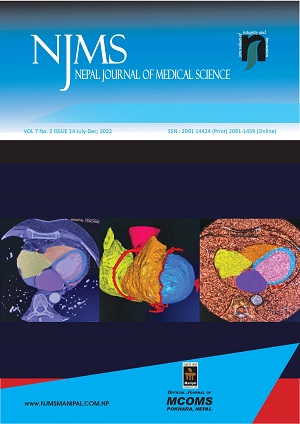Knowledge Attitude and Practice of Cervical Cancer Screening Among the Healthcare Workers of Western Region, Nepal
DOI:
https://doi.org/10.3126/njms.v7i2.47211Keywords:
Health Knowledge, Attitudes, Practice, Papillomavirus Infections, Uterine Cervical NeoplasmsAbstract
Introduction: Cancer cervix being the only preventable cancer in the world is still the leading cause of cancer-related death in developing countries. Awareness and screening programs are a must for health care workers whose direct impact goes on society. Healthy people are found to be given services, but their health is often neglected. This study highlights health care workers' knowledge, attitude and practices on cervical cancer screening. This study aims to assess healthcare workers' knowledge, attitude and practice toward cervical cancer screening in the western region, of Nepal.
Methods: A semi-structured questionnaire was distributed to health care workers from September 2020 to March 2021 eligible to participate in the study were included. A total of 115 participants were enrolled in the study. A descriptive measure for socio-demographic data was done. Determinants of knowledge and practice for screening were determined using the Chi-square test.
Results: The mean age of the participant was 27.92±5.49 (SD). More than half had poor knowledge (51%), followed by moderate knowledge (37%) and less than one eight had good knowledge (12%). 92 % know that cervical cancer is preventable but very less have undergone screening tests.
Conclusion: There is an urgent need for educational intervention to change their attitude towards HPV vaccination and encourage cervical cancer screening program that helps in the prevention of cervical cancer. HPV vaccination should be kept in the immunization schedule and made easily available at a low cost.
Downloads
Downloads
Published
How to Cite
Issue
Section
License
Copyright (c) 2022 Nepal Journal of Medical Sciences

This work is licensed under a Creative Commons Attribution 4.0 International License.
Copyright © by Nepal Journal of Medical Sciences. The ideas and opinions expressed by authors of articles summarized, quoted, or published in full text in this Journal represents only opinions of authors and do not necessarily reflect the official policy of Nepal Journal of Medical Sciences or the institute with which the author(s) is (are) affiliated, unless so specified.




